Kachina Dancers (Indians Forever Suite) by Fritz Scholder - C3984A
 Fritz Scholder (1937-2005) was a world-renowned painter of Luiseño descent. Scholder, who at one point had vowed never to create works with Native themes or subject matter, became a widely influential figure in the world of Native American art. His Indians Forever Suite, created at Albuquerque's Tamarind Institute in the early 1970s, was the beginning of Scholder's experimentation with lithography.
Fritz Scholder (1937-2005) was a world-renowned painter of Luiseño descent. Scholder, who at one point had vowed never to create works with Native themes or subject matter, became a widely influential figure in the world of Native American art. His Indians Forever Suite, created at Albuquerque's Tamarind Institute in the early 1970s, was the beginning of Scholder's experimentation with lithography.
In "Kachina Dancers", Scholder presents a straightforward depiction of a ceremony that is of the utmost importance to the Hopi people: the Niman (or "Going Home") ceremony. This ceremony marks the end of the six-month period during which, according to Hopi tradition, the Katsinas live among the Hopi people, revealing themselves through ceremonial dances and serving as the Hopi people's links to their gods. The katsinas pictured here are called Hemis Katsinas.
#adobegallery #SouthwestIndianPainting #NativeAmericanPainting # Luiseño #PuebloPaintings #SantaFeNM #FineArt #Print #FritzScholder
Historic San Ildefonso Pueblo Large Globular Polychrome Olla - C4068F
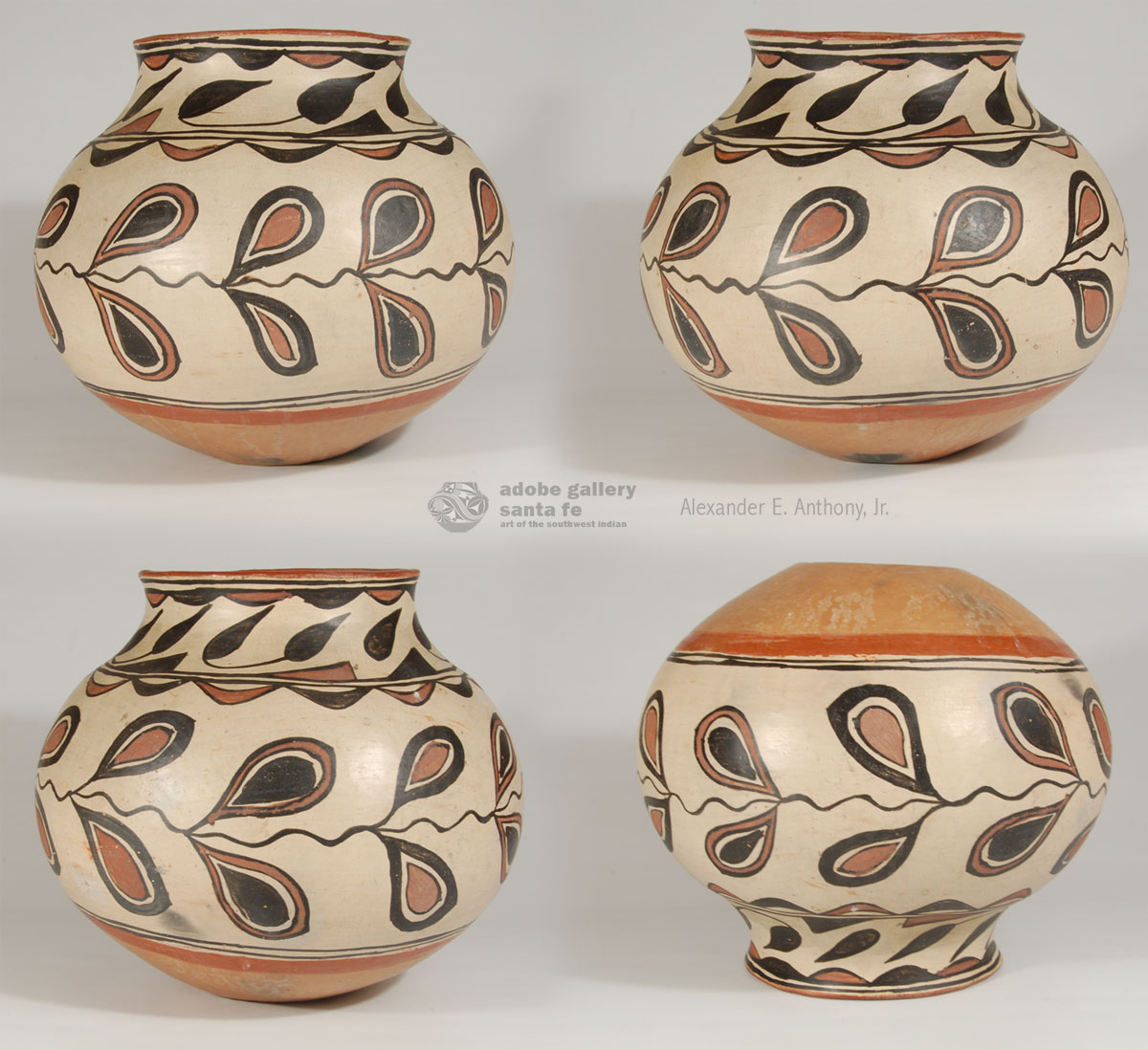 Long before Black-on-black pottery became the staple at San Ildefonso Pueblo, potters there had produced a variety of historic pottery types: Black-on-cream, Black-on-red and Polychrome types predominantly. Powhoge Polychrome, which was black-on-cream, in the 1850-1880 period, gave way to San Ildefonso Polychrome, starting in the 1890s, in which red paint was added to the design. Concurrently, some potters began abandoning the red paint on the rim in favor of black, around the same time.
Long before Black-on-black pottery became the staple at San Ildefonso Pueblo, potters there had produced a variety of historic pottery types: Black-on-cream, Black-on-red and Polychrome types predominantly. Powhoge Polychrome, which was black-on-cream, in the 1850-1880 period, gave way to San Ildefonso Polychrome, starting in the 1890s, in which red paint was added to the design. Concurrently, some potters began abandoning the red paint on the rim in favor of black, around the same time.
This jar is globular in shape, similar to Powhoge Polychrome, with the addition of a rolled out rim, a shape seen in early San Ildefonso Polychrome. The cream slip was stone polished, the slip used before potters changed to Cochiti slip around 1905, which did not require stone polishing. The black vegetal paint and the red paint used in the design of this jar are very strong and bold. The deep red paint seen in San Ildefonso pottery is the same paint used by the men for body decoration. The lighter red, almost orange, seen on later pottery is from another clay source. It is estimated that this jar dates to circa 1890 or maybe a decade earlier.
#adobegallery #SouthwestIndianPottery #SanIldefonsoPueblo #SanIldefonsoPottery #PuebloPottery #SouthwestIndianArt #SantaFePottery #FinePuebloPottery #HistoricPottery
Cochiti Pueblo Serigraph of Two Colorful Parrots by Joe Herrera - 26087
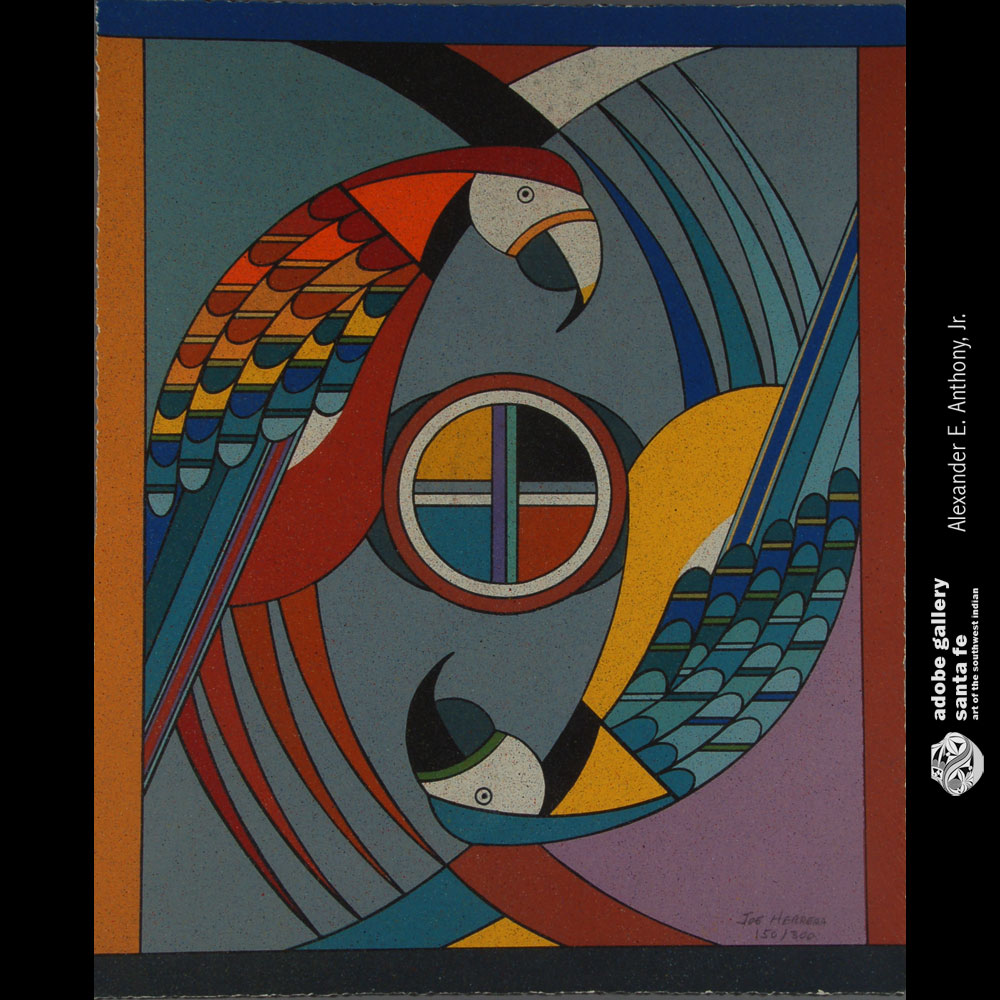 Joe Hilario Herrera (1923-1990s) See Ru was an innovative and successful Native American painter. His father was from Cochiti Pueblo, and his mother-pioneering painter Tonita Vigil Peña (1893-1949) Quah Ah-from San Ildefonso. Though his artistic inheritance and early art education came from his mother, Herrera is considered to be from Cochiti pueblo. He attended the Santa Fe Indian School, served in the US Army during World War II, worked at the Laboratory of Anthropology, and eventually completed a degree in art education at the University of New Mexico.
Joe Hilario Herrera (1923-1990s) See Ru was an innovative and successful Native American painter. His father was from Cochiti Pueblo, and his mother-pioneering painter Tonita Vigil Peña (1893-1949) Quah Ah-from San Ildefonso. Though his artistic inheritance and early art education came from his mother, Herrera is considered to be from Cochiti pueblo. He attended the Santa Fe Indian School, served in the US Army during World War II, worked at the Laboratory of Anthropology, and eventually completed a degree in art education at the University of New Mexico.
His early works were very much in keeping with the style of his mother and her contemporaries. He painted pueblo dancers in very traditional Indian School style-flat dimension, no ground plane, no background or landscape. Later in his career, because of the influence of modernist artist Raymond Jonson of the University of New Mexico art department, he took an interest in abstract and modernist painting. He was one of the first Indian artists to move away from traditional representational art into the more abstract forms of self-expression.
#adobegallery #SouthwestIndianPainting #NativeAmericanPainting #CochitiPueblo #PuebloPaintings #SantaFeNM #FineArt #Painting #JoeHerrera
Navajo Painting of a Horse “King of The Wild” by Quincy Tahoma - C4066B
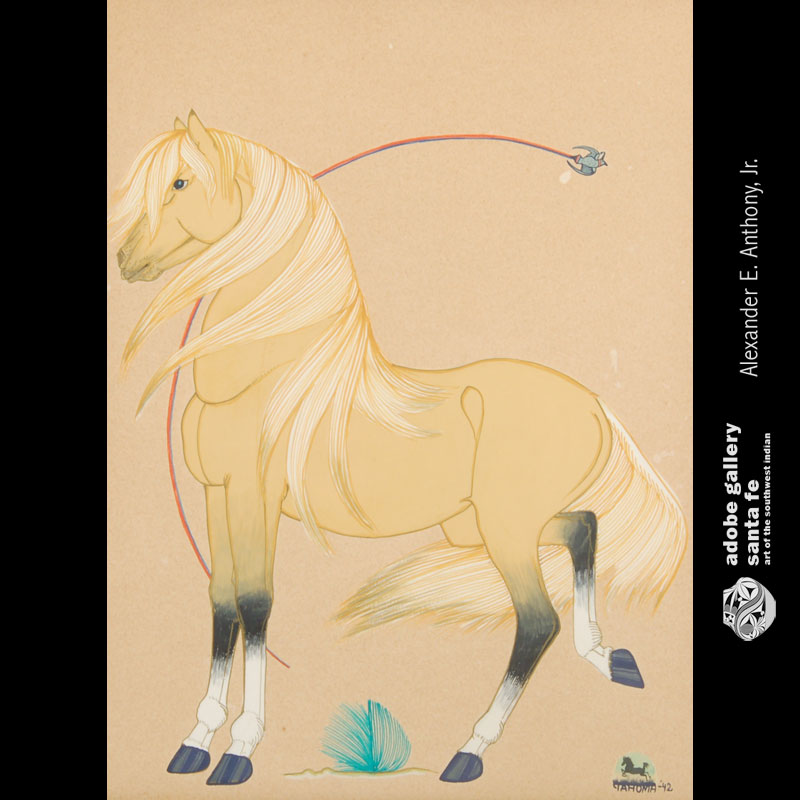 Quincy Tahoma (1917-1956) was a talented Navajo painter who was initially educated in the arts by Dorothy Dunn at the Santa Fe Indian School (The Studio). Alongside fellow Navajo painters like Harrison Begay and Gerald Nailor, Tahoma learned to create simple, boldly-colored watercolor paintings that depicted Native life and religious rituals. These artists' subjects were usually pictured in profile and with little background or ground plane. These "flat-style" or "studio style" paintings were and still are popular with collectors of Native American Art.
Quincy Tahoma (1917-1956) was a talented Navajo painter who was initially educated in the arts by Dorothy Dunn at the Santa Fe Indian School (The Studio). Alongside fellow Navajo painters like Harrison Begay and Gerald Nailor, Tahoma learned to create simple, boldly-colored watercolor paintings that depicted Native life and religious rituals. These artists' subjects were usually pictured in profile and with little background or ground plane. These "flat-style" or "studio style" paintings were and still are popular with collectors of Native American Art.
Tahoma, a naturally gifted artist, evolved quickly as a painter. His earlier works focused mostly on everyday Navajo life-the scenes he witnessed every day during his childhood. As he grew older and more technically adept, he focused his attention on more complicated scenes. Many of his best images feature muscular Navajo hunters clashing with their surroundings. His works are full of movement and action, but rarely feel violent or indulgent. Tahoma's life and career were, unfortunately, cut short by alcoholism. He passed away in 1956 at age 39. Fortunately for those who appreciate his works, he was very prolific and left behind a large body of work.
#adobegallery #SouthwestIndianPainting #NativeAmericanPainting #FineArt #Painting #Navajo #Diné #SantaFeNM #FinePuebloPainting #QuincyTahoma
Laguna Pueblo Floral Design Historic Jar - C4075
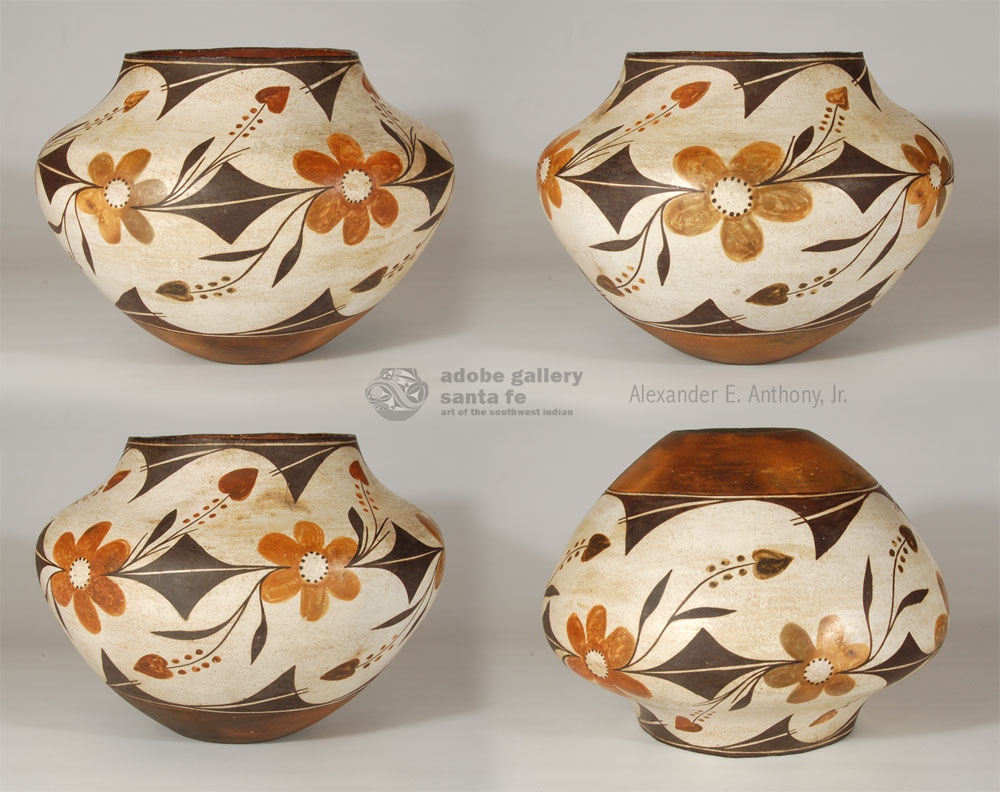 It is well recognized that it is difficult to determine if a particular jar was made at Laguna Pueblo in the early 20th century because they have a similarity to those made at Acoma Pueblo. It is easier to attribute a jar to having been made at Acomo, thereby eliminating the justification for having stated it was made at Laguna. If Rick Dillingham was correct in his analysis of pottery from Acoma and Laguna Pueblos, then we have some design facts to use as justification for selecting Laguna as the origin of a jar.
It is well recognized that it is difficult to determine if a particular jar was made at Laguna Pueblo in the early 20th century because they have a similarity to those made at Acoma Pueblo. It is easier to attribute a jar to having been made at Acomo, thereby eliminating the justification for having stated it was made at Laguna. If Rick Dillingham was correct in his analysis of pottery from Acoma and Laguna Pueblos, then we have some design facts to use as justification for selecting Laguna as the origin of a jar.
Rick Dillingham stated that an "open chain-like patterning is typical of Laguna wares." Dillingham 1992
#adobegallery #SouthwestIndianPottery #LagunaPueblo #LagunaPottery #PuebloPottery #SouthwestIndianArt #SantaFePottery #FinePuebloPottery #HistoricPottery
Navajo Silver and Turquoise Bracelet with Single Stone - C4069W
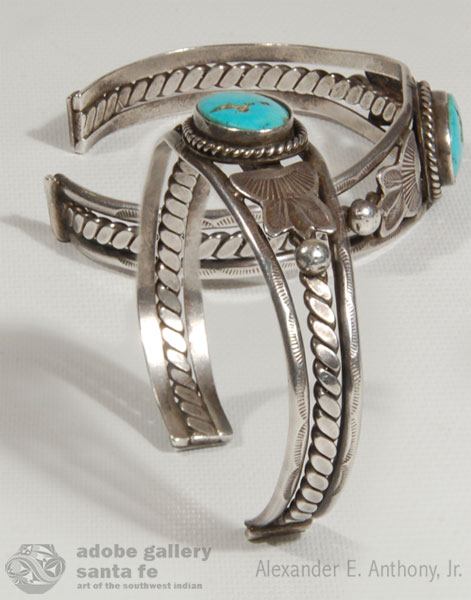 This single stone bracelet is a classic Navajo creation from the 1950s or 1960s. A single high- grade turquoise cabochon rests in a plain handmade bezel surrounded by thin twisted silver wire. This then rests on three wire bands-two solid and one twisted. The solid bands have delicate stampwork. On either side of the center are stamped appliqué sections with single silver drops. The bracelet is unsigned.
This single stone bracelet is a classic Navajo creation from the 1950s or 1960s. A single high- grade turquoise cabochon rests in a plain handmade bezel surrounded by thin twisted silver wire. This then rests on three wire bands-two solid and one twisted. The solid bands have delicate stampwork. On either side of the center are stamped appliqué sections with single silver drops. The bracelet is unsigned.
#adobegallery #SouthwestIndianJewelry #Navajo #Diné #Silver #Turquoise #Jewelry #SantaFeNM #NavajoJewelry #SantaFeJewelry
Navajo Single Turquoise Cab Set in Lacy Silver Wire Ring - C4070W
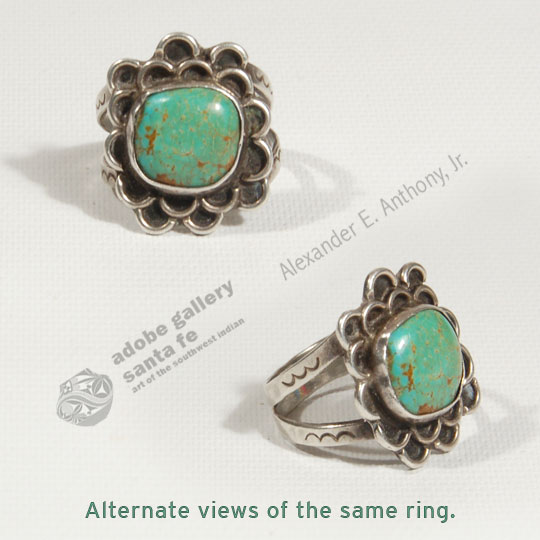 A series of small crescent-shaped pieces of silver mimic the petals of a flower surrounding a pretty, green turquoise cabochon in this lovely Navajo-made ring. An innovative Diné artist created this unique frame to highlight the beauty of an irregularly-shaped turquoise stone.
A series of small crescent-shaped pieces of silver mimic the petals of a flower surrounding a pretty, green turquoise cabochon in this lovely Navajo-made ring. An innovative Diné artist created this unique frame to highlight the beauty of an irregularly-shaped turquoise stone.
Rather than cut the turquoise to fit the setting, the artist made the setting fit the stone. The artist created an asymmetrical frame consisting of tiny silver wires shaped in half circles resembling the lacy texture of a flower.
#adobegallery #SouthwestIndianJewelry #Navajo #Diné #Silver #Turquoise #Jewelry #SantaFeNM #NavajoJewelry #SantaFeJewelry
Zuni Square Top Ring with Diamond Shape Turquoise Set in Silver - C4070A
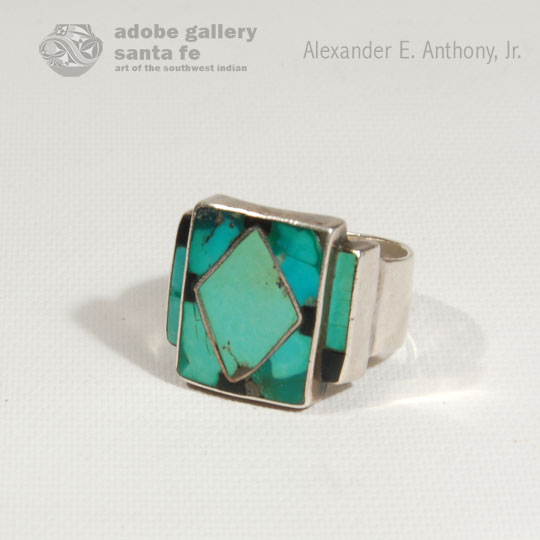 By all indications, this Zuni Pueblo-made ring dates from the 1930s or 1940s. It was artistically crafted, with sections of light green turquoise and jet set in silver channels. The center features a diamond- shaped turquoise cab placed in silver channels with jet at each of its corners, which was then set in a frame of silver channels and turquoise.
By all indications, this Zuni Pueblo-made ring dates from the 1930s or 1940s. It was artistically crafted, with sections of light green turquoise and jet set in silver channels. The center features a diamond- shaped turquoise cab placed in silver channels with jet at each of its corners, which was then set in a frame of silver channels and turquoise.
#adobegallery #SouthwestIndianJewelry #NativeAmericanJewelry #zuniJewelry #ZuniPueblo #Silver #Turquoise #Ring #SantaFeJewelry
Original Navajo Painting of a Colorful Bird at Night by Chethlahe - C4061
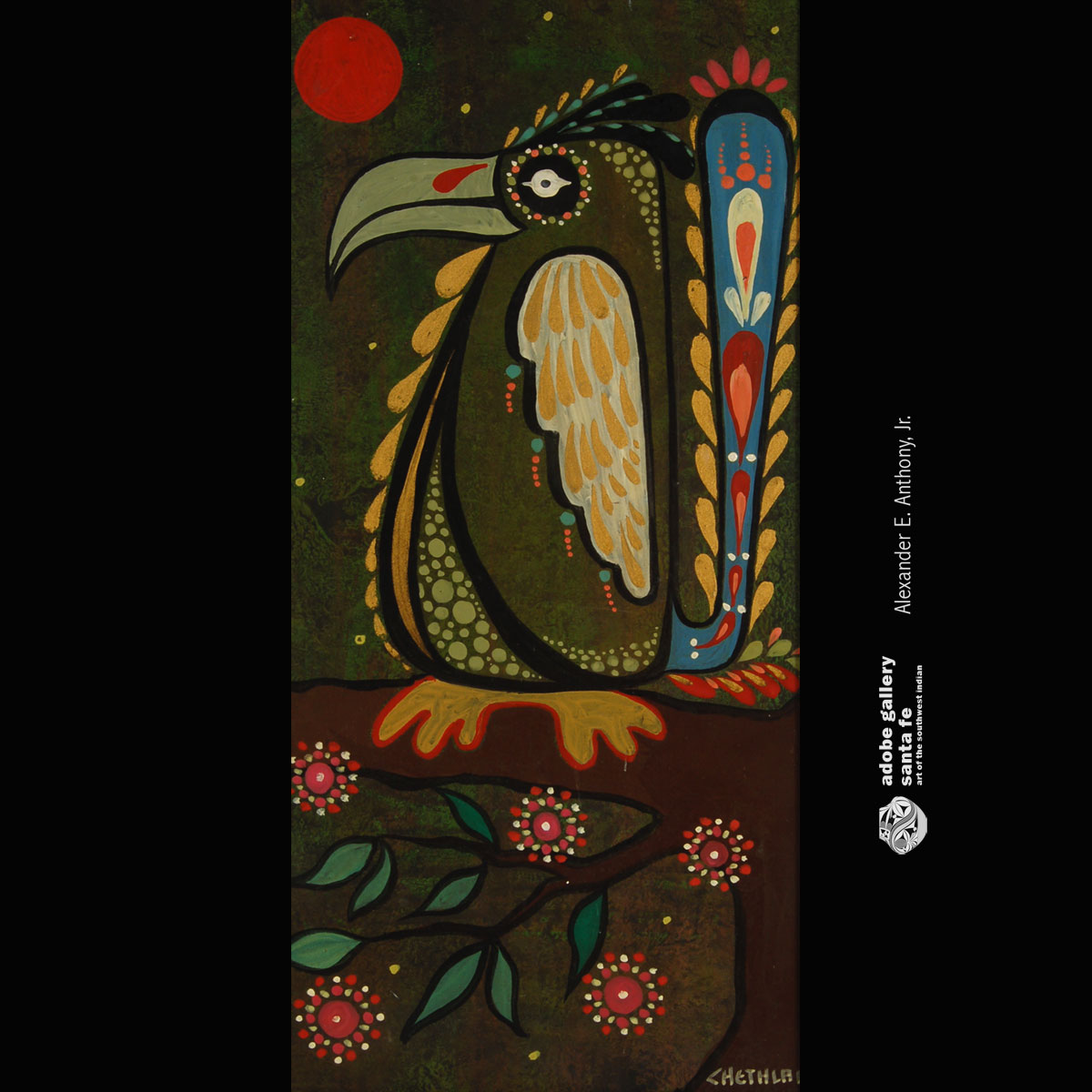 David Chethlahe Paladin (1926-1984) was a student of the Santa Fe Indian School, where he learned the basic fundamentals of painting from Dorothy Dunn. Dunn encouraged her students to document and celebrate their cultures. As a young man, Paladin struggled with his identity as the mixed-race son of a Navajo woman and a visiting white missionary. As he developed as an artist, he began to display a genuine affection for his Navajo culture. His style evolved considerably over the years, and ultimately drew from a wide variety of influences while always remaining grounded in his Native American roots. Paladin-a recovering addict and World War II prisonor of war survivor-was eventually trained as a shaman, using his uniquely challenging life experiences to serve the Huichol and Tarahumara tribes in Mexico as well as his native Navajo people, or *Diné.
David Chethlahe Paladin (1926-1984) was a student of the Santa Fe Indian School, where he learned the basic fundamentals of painting from Dorothy Dunn. Dunn encouraged her students to document and celebrate their cultures. As a young man, Paladin struggled with his identity as the mixed-race son of a Navajo woman and a visiting white missionary. As he developed as an artist, he began to display a genuine affection for his Navajo culture. His style evolved considerably over the years, and ultimately drew from a wide variety of influences while always remaining grounded in his Native American roots. Paladin-a recovering addict and World War II prisonor of war survivor-was eventually trained as a shaman, using his uniquely challenging life experiences to serve the Huichol and Tarahumara tribes in Mexico as well as his native Navajo people, or *Diné.
Paladin's work evolved drastically over the course of his career, moving away from what was common among Native American artists of his time towards more abstract contemporary work. Though his methods changed over time, his preferred themes remained the same: spirituality, creation, and rebirth. Paladin depicted the same rituals, ceremonies and symbols as many of his Navajo contemporaries, but did so from a unique, constantly evolving perspective.
#adobegallery #SouthwestIndianPainting #NativeAmericanPainting #Navajo #PuebloPaintings #SantaFeNM #FineArt #Painting #Chethlahe
Rare Historic San Ildefonso Pueblo Very Large Dough Bowl - C4068B
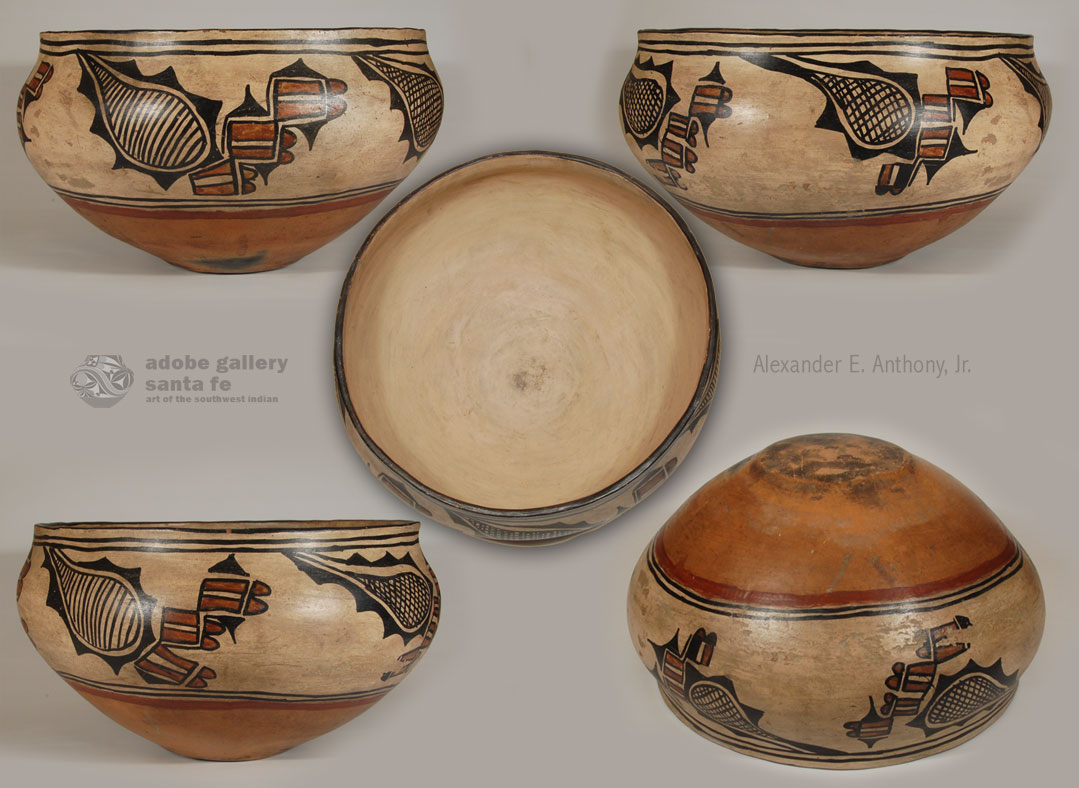 From extensive research, many early potters of San Ildefonso Pueblo have been identified and, in some cases, associated with some of their early works. Jonathan Batkin has associated some of the fine examples of San Ildefonso Polychrome pottery with Martina Vigil (1856-1916) and Florentino Montoya (1858-1918); Tonita Peña - Ba Tse - (1847-c.1910); Marianita Roybal (c.1850-c.1910); Dominguita Pino (1860-1948); and Tonita Roybal (1892-1945). The 1910 census lists eight women as potters by occupation. Batkin 1987:45
From extensive research, many early potters of San Ildefonso Pueblo have been identified and, in some cases, associated with some of their early works. Jonathan Batkin has associated some of the fine examples of San Ildefonso Polychrome pottery with Martina Vigil (1856-1916) and Florentino Montoya (1858-1918); Tonita Peña - Ba Tse - (1847-c.1910); Marianita Roybal (c.1850-c.1910); Dominguita Pino (1860-1948); and Tonita Roybal (1892-1945). The 1910 census lists eight women as potters by occupation. Batkin 1987:45
Dr. Bruce Bernstein is working on establishing the connection between male members who painted pottery for their mothers, sisters, and wives. Few female potters painted their own wares, leaving the art painting to male members of the family.
Batkin stated that "Tonita Peña's pots are among the most beautiful made at San Ildefonso at the turn of the century, and like Martina Vigil, Tonita Peña was among the last potters capable of making large storage jars." Batkin 1991:59
#adobegallery #SouthwestIndianPottery #SanIldefonsoPueblo #SanIldefonsoPottery #PuebloPottery #SouthwestIndianArt #SantaFePottery #FinePuebloPottery #HistoricPottery
Navajo Silver and Turquoise Stone Bracelet with Scallop Edges - C4069A
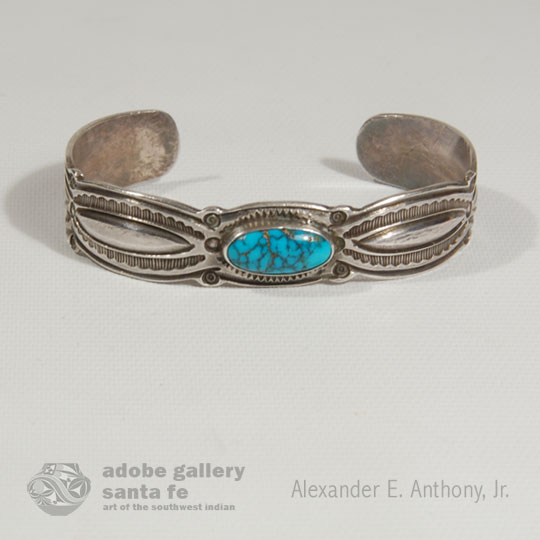 An elongated piece of high grade spiderweb turquoise rests on a band of sterling silver which has been decorated with repoussé domes. The repoussé technique requires the artist to work on the reverse side of the metal to form a raised design on the front. On this bracelet the raised ovals are framed with intricate sets of stampwork which accentuate the scalloped shape of the bracelet.
An elongated piece of high grade spiderweb turquoise rests on a band of sterling silver which has been decorated with repoussé domes. The repoussé technique requires the artist to work on the reverse side of the metal to form a raised design on the front. On this bracelet the raised ovals are framed with intricate sets of stampwork which accentuate the scalloped shape of the bracelet.
As is customary in Diné silverwork, the silver setting serves as a frame to accent the beauty of a single piece of turquoise. The center turquoise cabochon in this bracelet is robin's egg blue with a beautiful matrix. The piece was made in the mid-20th century, but is not a tourist piece, as the silver is more substantial than what was used in a typical Fred Harvey souvenir. The unsigned bracelet was created by an unknown, but highly skilled, silversmith.
#adobegallery #SouthwestIndianJewelry #Navajo #NavajoNation #Silver #Turquoise #Jewelry #SantaFeNM #NavajoJewelry
Historic Laguna Pueblo Small Olla with Boldly Colored Flowers - C4068o
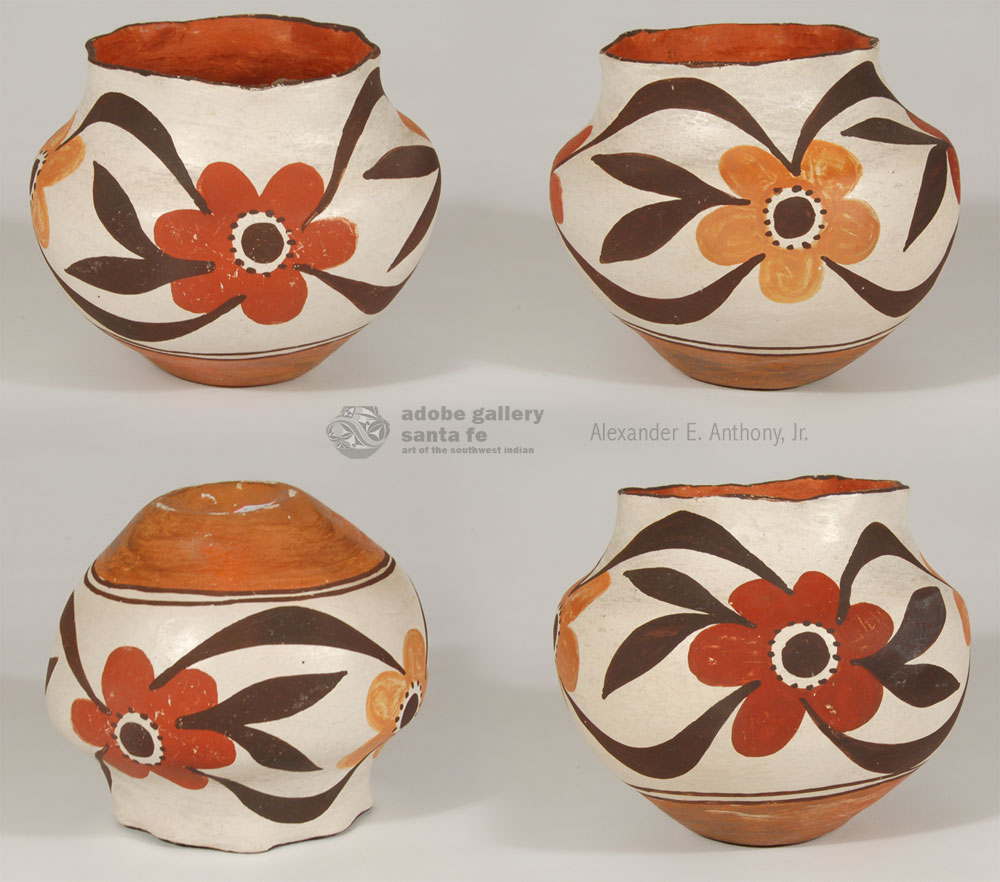 Laguna Pueblo is a nearby neighbor of Acoma Pueblo in Western New Mexico. Laguna was founded in 1699 by members of Acoma, Zuni and other pueblos following the upheavals and disruptions caused by the The Pueblo Revolt of 1680-also known as Popé's Rebellion. Pottery from Laguna resembles that of Acoma and it is generally difficult to distinguish between the two. Some designs, however, seemed to predominate at Laguna and those differed from designs used at Acoma.
Laguna Pueblo is a nearby neighbor of Acoma Pueblo in Western New Mexico. Laguna was founded in 1699 by members of Acoma, Zuni and other pueblos following the upheavals and disruptions caused by the The Pueblo Revolt of 1680-also known as Popé's Rebellion. Pottery from Laguna resembles that of Acoma and it is generally difficult to distinguish between the two. Some designs, however, seemed to predominate at Laguna and those differed from designs used at Acoma.
When the transcontinental train came to New Mexico, it passed directly adjacent to Laguna Pueblo and there was a depot nearby. The train made stops at the pueblo to allow the travelers to purchase wares from the potters. The Laguna potters soon realized that the travelers preferred vessels that were easy to transport in their luggage or hand carry on the train. It was then that smaller versions of traditional vessel shapes developed.
#adobegallery #SouthwestIndianPottery #LagunaPueblo #IsletaPottery #PuebloPottery #SouthwestIndianArt #SantaFePottery #FinePuebloPottery #HistoricPottery
Navajo Silver and Turquoise Bracelet with Three Beautiful Stones - C4069C
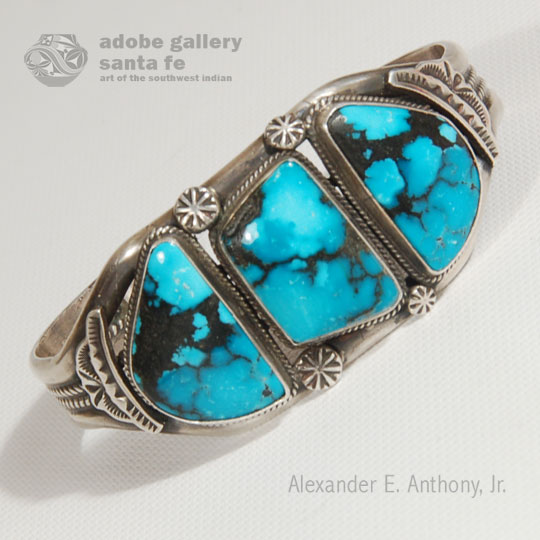 Three stunning deep blue cabochons are the centerpiece of this unique bracelet. As we are not experts in turquoise, we are not going to attempt to label the source of these stones. The depth and variation in color are spectacular regardless of its origin. The center cabochon is an irregular shaped rectangle set in a smooth handmade bezel surrounded by a small twisted wire and four star shaped silver drops. On either side of the center are two similarly shaped stones whose remarkable black matrix adds an almost three dimensional aspect to the bracelet.
Three stunning deep blue cabochons are the centerpiece of this unique bracelet. As we are not experts in turquoise, we are not going to attempt to label the source of these stones. The depth and variation in color are spectacular regardless of its origin. The center cabochon is an irregular shaped rectangle set in a smooth handmade bezel surrounded by a small twisted wire and four star shaped silver drops. On either side of the center are two similarly shaped stones whose remarkable black matrix adds an almost three dimensional aspect to the bracelet.
The three unique stones are carefully soldered onto a solid base consisting of two twisted wires and two substantial bars of sterling silver. A small stamped crescent is appliqued on each side at the top of the shank where the four sections of silver merge. The bracelet dates from the mid 20th century. Nature created a masterpiece when she created these stones and an unknown, talented Diné silversmith set the masterpiece in silver.
#adobegallery #SouthwestIndianJewelry #Navajo #NavajoNation #Silver #Turquoise #Jewelry
#SantaFeNM #NavajoJewelry #TheCityDifferent
Apache Very Large Pictorial Basket Bowl - C4068C
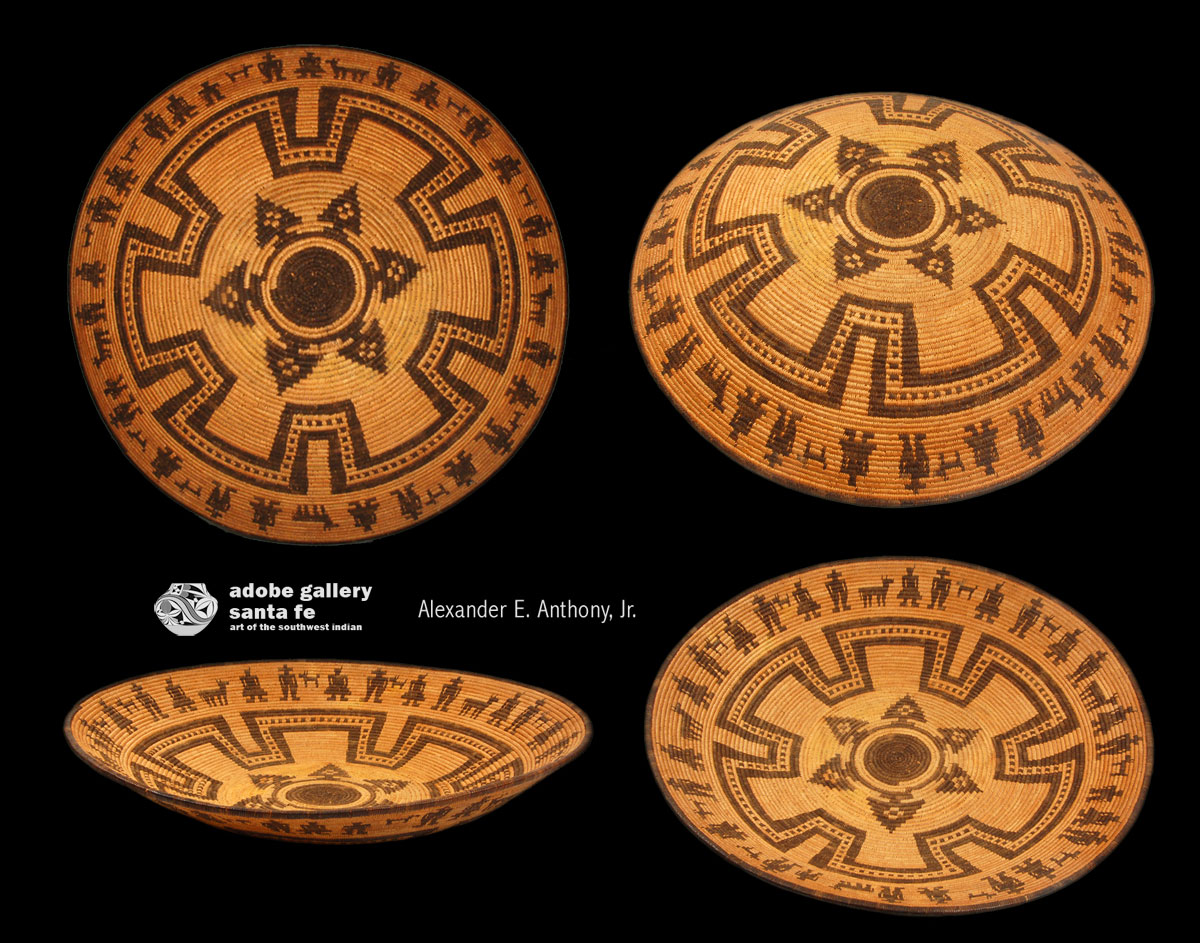 There are some baskets that demand one's attention and admiration. This world-class Apache basket bowl is large in size (22 inches) and amazing in design-39 animal and human figures. Such a basket must have required a year or more to make. The materials used for making it had to be gathered in a particular season when they were mature. Once gathered and stored, each blade of material had to be treated individually, such as splitting each to the correct width for the weft design. Devil's claw requires peeling the skin off the core of the plant. Foundation rods require soaking so that they can be properly bent.
There are some baskets that demand one's attention and admiration. This world-class Apache basket bowl is large in size (22 inches) and amazing in design-39 animal and human figures. Such a basket must have required a year or more to make. The materials used for making it had to be gathered in a particular season when they were mature. Once gathered and stored, each blade of material had to be treated individually, such as splitting each to the correct width for the weft design. Devil's claw requires peeling the skin off the core of the plant. Foundation rods require soaking so that they can be properly bent.
Once all the materials have been gathered and prepared, the weaver can start making the basket. A basket of this size certainly could have taken her a year to complete. Each of the animal and human figures and other designs required a change of materials during the weaving process. This is a time-consuming procedure . To undertake such a monumental project requires the patience and skill of a master weaver.
#adobegallery #SouthwestIndianBaskets #Apache #Baskets #ApacheBaskets #IndianBaskets
#SantaFeNM #VisitCanyonRoad
Historic Isleta Pueblo Polychrome Small Serving Bowl - C3924S
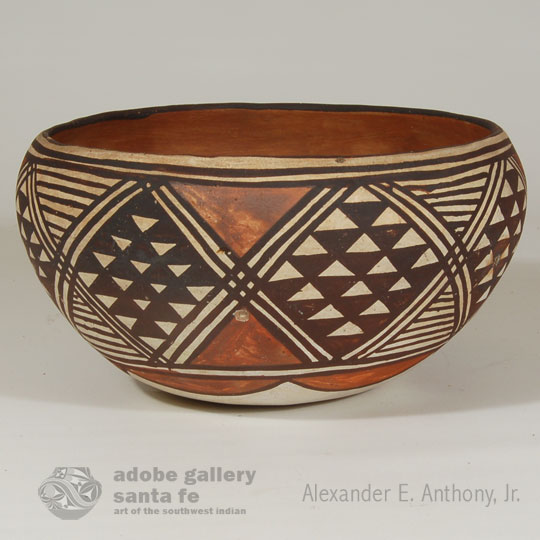 This bowl is typical of Isleta Polychrome pottery from 1880 to the present. At that time, Isleta potters learned new techniques and new designs to replace the traditional orange wares that were devoid of design. The poor quality red clay at Isleta was not suitable for making high-quality thin-walled pottery. Pottery from Isleta of that time is not in large quantity in any museum collection because it was not considered worthy of such. When one looks at it today, however, it is amazingly beautiful in its color purity and simplicity.
This bowl is typical of Isleta Polychrome pottery from 1880 to the present. At that time, Isleta potters learned new techniques and new designs to replace the traditional orange wares that were devoid of design. The poor quality red clay at Isleta was not suitable for making high-quality thin-walled pottery. Pottery from Isleta of that time is not in large quantity in any museum collection because it was not considered worthy of such. When one looks at it today, however, it is amazingly beautiful in its color purity and simplicity.
The change occurred in 1880 when a large group of Laguna Pueblo Indians permanently moved and set up a village near Isleta which they named Oraibi. The massive move was a result of a dispute within Laguna. The Laguna women were makers of polychrome pottery and they took the techniques and designs with them. Not only were the designs and colors attractive to potters at Isleta, the Laguna potters knew how to use proper temper to achieve strong and thin walls. Eventually, the Laguna style became the Isleta style and Laguna designs still appear today on pottery from Isleta.
#adobegallery #SouthwestIndianPottery #IsletaPueblo #IsletaPottery #PuebloPottery #SouthwestIndianArt #SantaFePottery #FinePuebloPottery #HistoricPottery
Zuni Pueblo Large Pottery Owl with two Owlets - C3974D
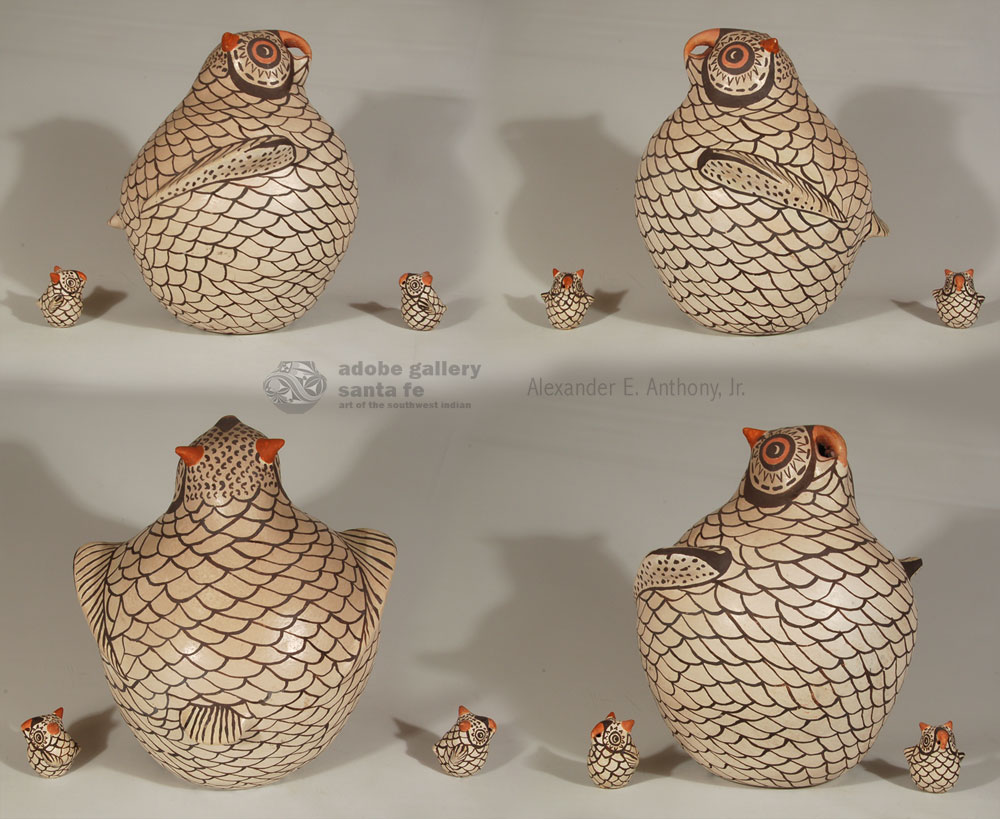 Pottery making at Zuni almost died out at the beginning of the 20th Century. Believing the Zuni were a "vanishing race," anthropologists from Eastern museums participated in the almost complete removal of pottery from the Pueblo. Boxcars were filled with ollas, dough bowls and other examples of Zuni material culture and sent back East. Young potters had no examples to look at, and residents of the pueblo had to rely on commercially-made vessels and containers for daily use. The art and tradition of pottery making almost died out. Because jewelry was easier to ship, traders encouraged artists to make jewelry instead of pottery.
Pottery making at Zuni almost died out at the beginning of the 20th Century. Believing the Zuni were a "vanishing race," anthropologists from Eastern museums participated in the almost complete removal of pottery from the Pueblo. Boxcars were filled with ollas, dough bowls and other examples of Zuni material culture and sent back East. Young potters had no examples to look at, and residents of the pueblo had to rely on commercially-made vessels and containers for daily use. The art and tradition of pottery making almost died out. Because jewelry was easier to ship, traders encouraged artists to make jewelry instead of pottery.
It was not until the mid-20th Century, under the tutelage of Hopi potter Daisy Hooee, was there a revival of the tradition of pottery making. Hooee, the granddaughter of Hopi potter Nampeyo of Hano, was married to Sidney Hooee, a Zuni silversmith. She lived at Zuni and taught pottery making. Since that time, there has been a gradual revival of pottery making at Zuni.
#adobegallery #SouthwestIndianPottery #ZuniPueblo #PuebloPottery #SantaFePottery #FinePuebloPottery #SantaFeNM #ContemporaryPottery
Laguna Pueblo Small Historic Pottery Jar - C3925V
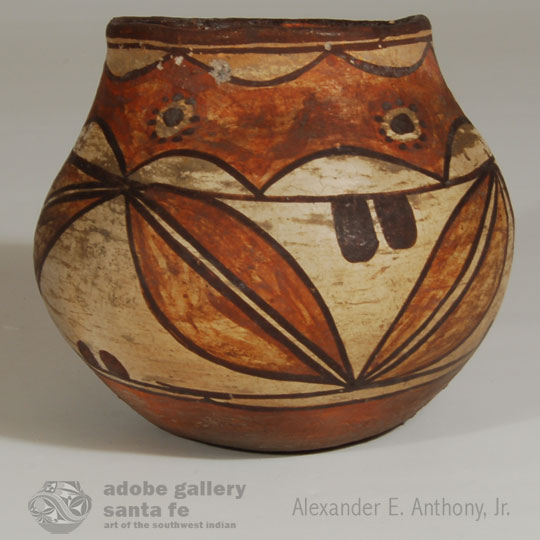 Small jars, such as this one, were certainly made for the tourist and collector market, as they had no daily function in a pueblo home. That does not diminish their importance in any way as they are just as historically relevant as something made for daily use in the home.
Small jars, such as this one, were certainly made for the tourist and collector market, as they had no daily function in a pueblo home. That does not diminish their importance in any way as they are just as historically relevant as something made for daily use in the home.
The design on the body is comprised of large split leaves and the neck design is a continuing rainbow arc. The jar tilts slightly and has an aged patina.
#adobegallery #SouthwestIndianPottery #LagunaPueblo #LagunaPottery #PuebloPottery #SouthwestIndianArt #SantaFePottery #FinePuebloPottery #HistoricPottery
Hopi Silver Overlay Belt with Talavai Katsina Mask by Manuel Hoyungowa - C4063E
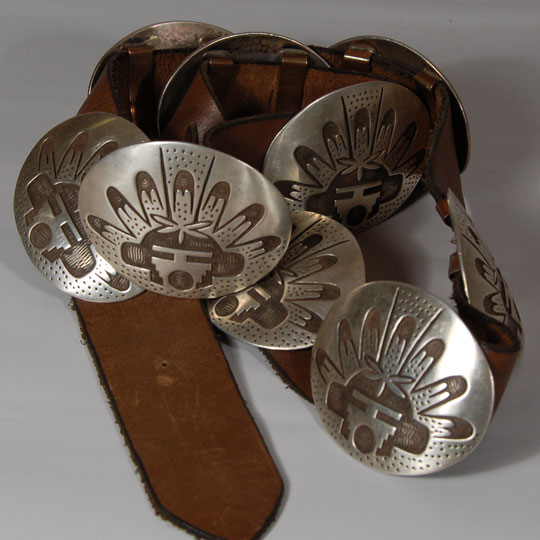 "The Talavai Kachina formerly appeared in pairs on the rooftops and sang songs, waking the people in the village. During the day they would dance with the other kachinas whom they led and prompted in the singing. This role is no longer used in any of the villages. They still appear with the other kachinas in the Powamu Ceremony and are most often standing in a set to one side of the main movement of the procession. Occasionally they sing as they stand holding their spruce trees and ringing their bells." Barton Wright 1973
"The Talavai Kachina formerly appeared in pairs on the rooftops and sang songs, waking the people in the village. During the day they would dance with the other kachinas whom they led and prompted in the singing. This role is no longer used in any of the villages. They still appear with the other kachinas in the Powamu Ceremony and are most often standing in a set to one side of the main movement of the procession. Occasionally they sing as they stand holding their spruce trees and ringing their bells." Barton Wright 1973
#adobegallery #SouthwestIndianJewelry #NativeAmericanJewelry #HopiJewelry #HopiPueblo #Silver #ConchaBelt #SantaFeNM #TheCityDifferent
Navajo Sterling Silver Cast Belt Buckle with Five Stones - C4063i
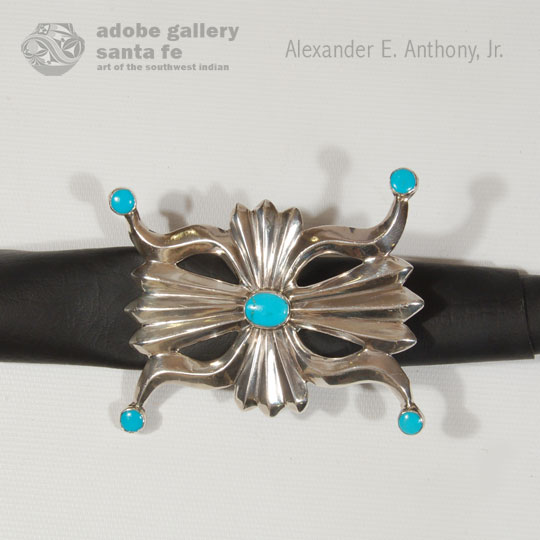 There is speculation about exactly when Navajos learned to work with silver, but most agree that the first smith was a man named Atsidi Sani (Old Smith). He went on to teach the craft to his relatives. By the beginning of the 20th Century, most parts of the reservation had working silversmiths.
There is speculation about exactly when Navajos learned to work with silver, but most agree that the first smith was a man named Atsidi Sani (Old Smith). He went on to teach the craft to his relatives. By the beginning of the 20th Century, most parts of the reservation had working silversmiths.
One of the first methods used by Navajo silversmiths was the casting method. A design was carved into tufa stone and molten silver poured into the mold. After it cooled the artist would remove the piece and finish it off by adding stones or other embellishments.
![]()
#adobegallery #SouthwestIndianJewelry #Navajo #Diné #Silver #Turquoise #Jewelry #SantaFeNM #NavajoJewelry #SantaFeJewelry
Navajo Very Large Crystal Trading Post Rug - C3925A
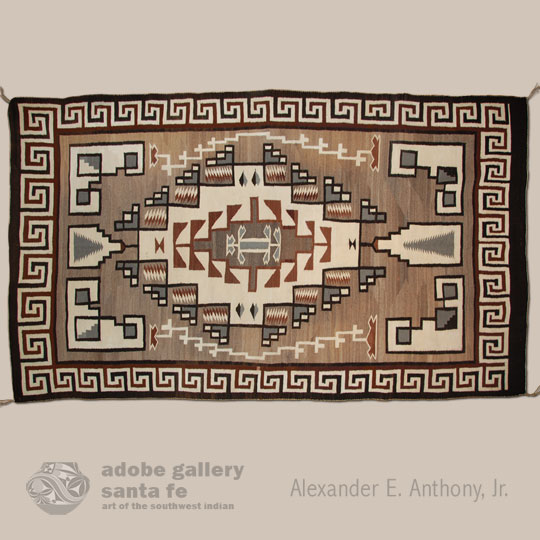 This is a Navajo Very Large Crystal Trading Post Rug, circa 1940s. The basic field of this Navajo textile was woven from all native wool, carded from brown sheep and white sheep, resulting in a beautiful blend of varying brown shades of color. The other carded color is gray, a blend of white and black yarns. It is possible that the black wool has been overdyed with commercial dye to enhance its color, otherwise, there is no dye in the rug.
This is a Navajo Very Large Crystal Trading Post Rug, circa 1940s. The basic field of this Navajo textile was woven from all native wool, carded from brown sheep and white sheep, resulting in a beautiful blend of varying brown shades of color. The other carded color is gray, a blend of white and black yarns. It is possible that the black wool has been overdyed with commercial dye to enhance its color, otherwise, there is no dye in the rug.
#adobegallery #Navajo #Textiles #Blankets #Rugs #Diné # CrystalTradingPost #NavajoRugs #SouthwestIndianTextiles #SantaFeNM #TheCityDifferent

